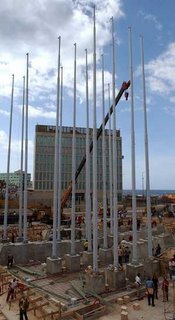Iran's ambassador in CubaFrom La Nueva Cuba has a article concerning Iran's ambassador visit to Cuba. Remember folks there is absolutely no connection with these two countries at all. Nevermind the visit, mini-me's love of Jews and Israel, and oh yes that nuclear thing in Iran:
Iran
Infosearch:
José Cadenas
Bureau Chief
USA LatinoaméricaResearch
Dept. La Nueva Cuba
January 24, 2006
Islamic Republic of Iran's Ambassador to Cuba Ahmad Edrisian conferred with that country's Government Minister Gabrisas in Havana on Monday.
According to Foreign Ministry Media Department, Edrisian during the meeting presented a report on bilateral economic ties, Iran's stand on its peaceful nuclear program, and President Mahmoud Ahmadinejad's recent proposal on status of observing the human rights in the West.
The Cuban minister, who is in charge of the two countries' joint economic commission, too, expressed satisfaction over the improving trend of the two countries' economic and business relations that he said are now stronger than ever before.
Gabrisas also expressed his support for the moves initiated jointly by Iran and Cuba to boost the bilateral economic ties.
The Cuban Government Minister also announced Havana's strong support for Tehran in its natural right to take advantage of the nuclear power.
He added, "Cuba's stands on human rights, too, are quite the same as Iran's and Havana is ready for cooperation with Tehran at all international scenes."









